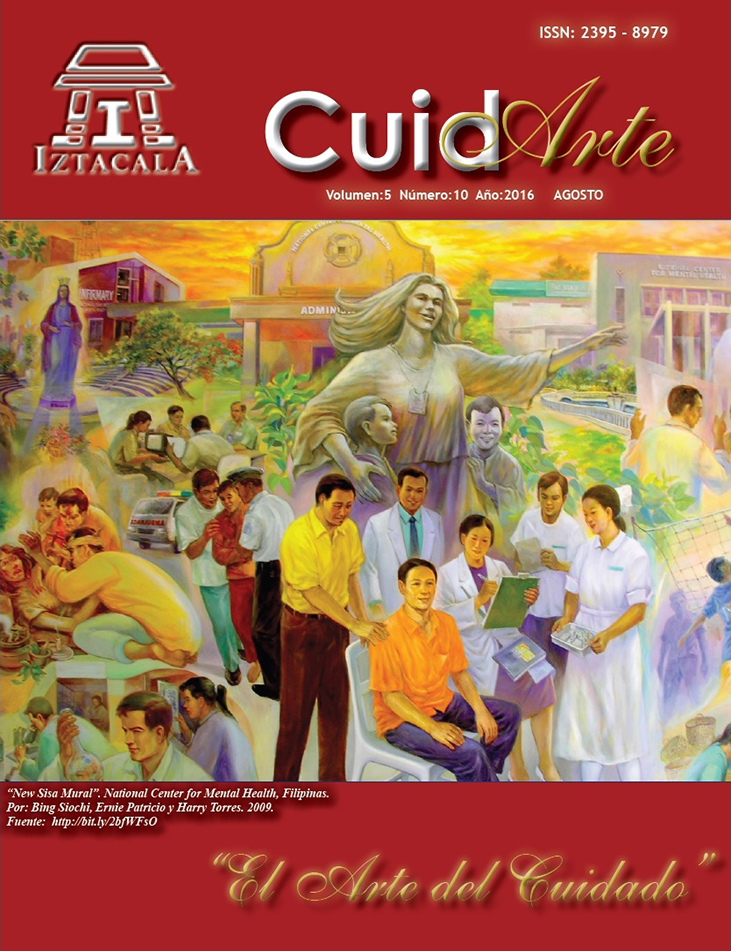Validation of an instrument for self-management of pain in elderly with osteoarthritis
Main Article Content
Abstract
Objective:
Validate an instrument that evaluates
the Self-Management of Pain in the Elderly with Osteoarthritis.
Methodology: Validation was
performed in 100 older adults with osteoarthritis,
patients of the National Centre for the Elderly in
the city of Saltillo; Coahuila, Mexico. Construct
validation was used and content through consensus
of expert opinion, cultural adaptation, Cronbach
Alpha and factor analysis.
Results: The results of
the maximum likelihood method showed a goodness
of fit test KMO (0.769) and adequate test Bartlett
3 factors; identifying the dimensions of signs and
symptoms, treatment adherence and knowledge of
the characteristics of chronic pain in osteoarthritis;
with a variance accounted for 62%. To demonstrate
the reliability of the construct, test measurement was
performed using the relationship between each item,
obtaining a Cronbach’s Alpha of .812. The reliability
coefficient of the construct related to the stability in
time between the test and retest is expressed with a
correlation “r” of Pearson 1 to 794 respectively, which
indicates that it has a significant positive correlation
at 0.01 level bilateral dependent between variables.
Conclusions: The instrument is a valid and reliable
tool in Spanish language to be used not only for
nursing but for all staff in the area of Health to
conduct screening Self-Management of Pain in Elderly
with Osteoarthritis. It is suggested to continue the
validation process in different or similar populations.
Downloads
Article Details
Citas en Dimensions Service
References
(1) INEGI: Instituto Nacional de Estadística, Geografía e Informática. XII Censo General de Población y Vivienda 2010. [acceso 14 marzo 2014]. Disponible en: http:// www.inegi.gob.mx.
(2) Benito Ruíz P, Calvet Fontova J, Lisbona Pérez P, Martínez Peromingo J, Möller Parera I, Monfort Faure J, et al. Artrosis: Guía de la buena práctica clínica en Geriatría. 1ª ed. Barcelona: Sociedad Española de Geriatría y Gerontología, Sociedad Española de Reumatología y Elsevier España; 2008.
(3) Bryce S. Trastornos y lesiones del sistema musculoesquelético. 3ª ed. España: Masson; 2004.
(4) Martínez-Elizondo, Introducción a la reumatología 3ª ed. México: Fondo Editorial CMR; 2003.
(5) Wieland HA, Michaelis M, Kirschbaum BJ, Rudolphi KA. Osteoarthritis-anuntreatable disease. Nat Rev Drug Discov. 2005; 4: 331-344.
(6) Vázquez AM, Núñez C, Juliá C, Núñez C. Valoración clínica e instrumental en la artrosis de rodilla. Rehabilitación [Internet]. 2009 [acceso 13 noviembre 2013]; 43(5):223-31. Disponible en: http://www.sciencedirect.com/scienceHYPERLINK.
(7) Giménez S, Gimeno A, Panero P, Casals JL. Recomendaciones de buena práctica clínica en artrosis. Semergen [Internet]. 2008 [acceso 14 noviembre 2013]; 34(6):321. Disponible en: http://dialnet.unirioja.es/servlet/articulo.
(8) Ballesteros F, Palma S, Radrigán F, Riedemann P, Verdejo U. Guía de Práctica Clínica en Osteoartritis. Reum [Internet]. 2005 [acceso 14 noviembre 2013]; 21(1):6-19. Disponible en: http://www.sochire.cl/bases/r-186-1-1343619763.pdf.
(9) Carmona L, Ballina R, Gabriel, Laffon A. The burden of musculoesqueletal diseases in the general population of Spain: results from a nacional survey. Ann Rheum Dis. 2001; 60: 1040-5.
(10) Battersby MW, Harvey PW, Mills PD, Kalucy E, Pols RG, Frith PA, et al. SA HealthPlus: a controlled trial of a statewide application of a generic model of chronic illness care. Milbank Quarterly. 2007; 85(1): 37–67.
(11) Battersby MW, Ask A, Reece M, Markwick MJ, Cllins JP. The Partners in Health scale: The development and psychometric properties of a generic assessment scale for chronic condition self-management. Australian Journal of Primary Healt. 2003; (2 y 3): 41-53.
(12) Petkov J, Harvey P, Battersby MW,The internal consistency and construct validity of a partners in health scale: Validation of a patient rated self-management measure. Qual Life Res. 2010; 19: 1079-1085.
(13) Peñarrieta De Córdova M, et al. Validación de un instrumento para evaluar el Automanejo de Enfermedades Crónicas en el primer nivel de atención en salud. Rev. Cient. de Enferm. 2012; 8 (1): 64-73.
(14) Peñarrieta De Córdova M, et al. Self-management in chronic conditions: Partners in Health scale instrument validation. Nursing Management. 2014; 20 (10): 32-38.
(15) Peñarrieta De Córdova M, et al. El Automanejo de Enfermedades Crónicas: Población de una jurisdicción de centros de salud. Rev. Enferm. Herediana. 2013; 6 (1): 42-49.
(16) Hernández Sampieri R, Fernández Callado C, Baptista Lucio P. Metodología de la investigación. 5ª ed. México: Mc. Graw Hill; 2010: 76-115.
(17) Castañeda Jiménez J, De la Torre Lozano M, Morán Rodríguez J, Lara Ramírez L. Metodología de la Investigación. 1ª ed. México, D. F.: Mc. Graw Hill; 2002: 81-256.
(18) Tamayo y Tamayo M. el proceso de la Investigación Científica. 5 a. ed. México, D. F. LIMUSA. 2012.
(19) Menéndez J. Guevara A, Arcia N, León-Díaz EM, Marín C, Alfonso JC. Enfermedades crónicas y limitación funcional en adultos mayores: estudio comparativo en siete ciudades de América Latina y el Caribe. Rev. Panam.Salud Pública. 2005; 17:353-361.
(20) Guía de Práctica Clínica, Diagnóstico y Tratamiento de Artritis Reumatoide en el Adulto. Instituto Mexicano del Seguro Social (IMSS). 2009.
(21) Borges-Yáñez A, Gómez-Dantés H. Uso de los servicios de salud por la población de 60 años y más en México. Instituto Nacional de Salud Pública, INSP. 1998; 40 (1): 1-11.

